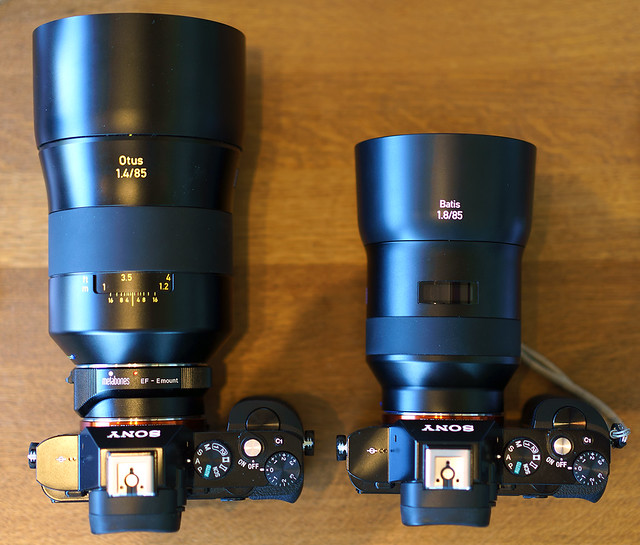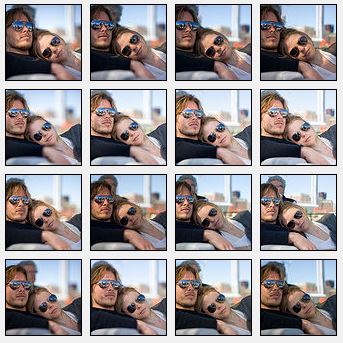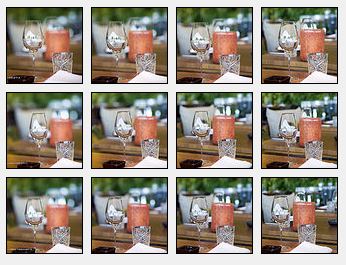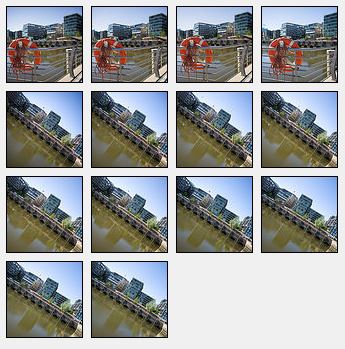In April 2015 ZEISS announced "Batis" - a new family of fullframe auto focus prime lenses for cameras with E-mount exclusively developed by ZEISS starting with the 2/25 and 1.8/85. Since then there was a lot of discussion but only few images visible on the internet so far. In June I had a first chance to take a series of pictures with a pre production set provided by ZEISS Germany. In order to classify the results you will see several comparison shots taken with some other high-class lenses.
ZEISS Batis 1.8/85
The Batis Sonnar 1.8/85 T* is designed with 11 elements in 8 groups and contains an autofocus as well as optical image stabilization. It has a length of 92mm (without lens cap / sun hood), weighs 475g and the filter thread is M67. More technical data including MTF charts can be found here.
Compared to the 1.2 kg ZEISS Otus 1.4/85 it looks quite compact:
Although there was not much time available for an in-depth shootout, we had the chance for some aperture series with the
- ZEISS Batis 1.8/85
- ZEISS Otus 1.4/85
- Leica APO Summicron 75mm f/2.0 ASPH
- Nikon AF-S Nikkor 85mm f/1.8 G (2012 model)
Click on the image below to see the full resolution aperture series (each titled with lens and aperture setting):
Athough the light conditions were varying and this was not ment as a scientific comparison, you will see that all four lenses deliver exceptionally good sharpness right from open aperture with a nice bokeh. From another - more elaborate - test I can say that the AF-S Nikkor sometimes tends to a more harsh bokeh but in this situation with a large distance to the background there was not a significant difference. The Otus seems to justify it's perfection with a little bit more micro contrast.
I saw a lot of discussion in forums about the pin-cushin distortion of 3% and Dr. Michael Pollmann explained to me that the Batis family leans on correction by software (camera firmware or lens profiles in raw processors) for design parameters that allow electronic correction easily in order to keep the lenses compact. In my opinion Zeiss has found a good compromise here and this type of distortion will not become noticeable even without correction as long as you are not shooting strong geometric objects like architecture (propably not the core area for a bright short tele lens that I would prefer for portraits).
Another feature of the uncompromising design of the Otus is it's apochromatic correction. To make differences visible, let's take a closer look at another series of sample shots:

(Batis 1.8/85 at open aperture)
Now let us take a closer look to some crops (without lens correction) at an area with edges / strong contrast changes in the bokeh close to the focal plane:
Zeiss Batis 1.8/85 (crop):
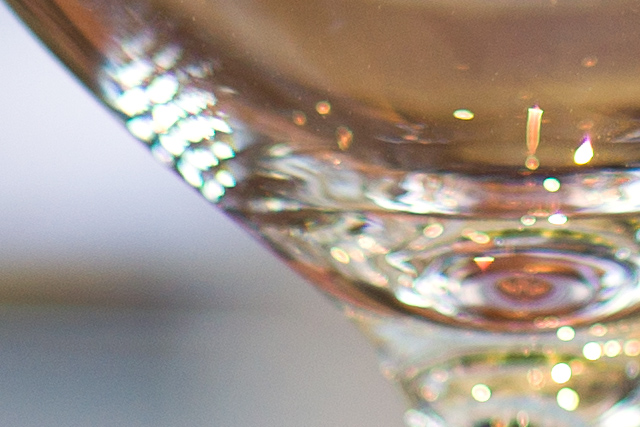
Nikon AF-S Nikkor 85mm f/1.8 G crop:
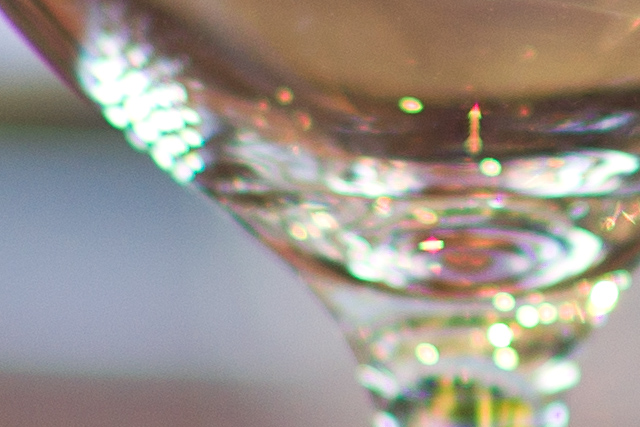
Zeiss Otus 1.4/85 crop:
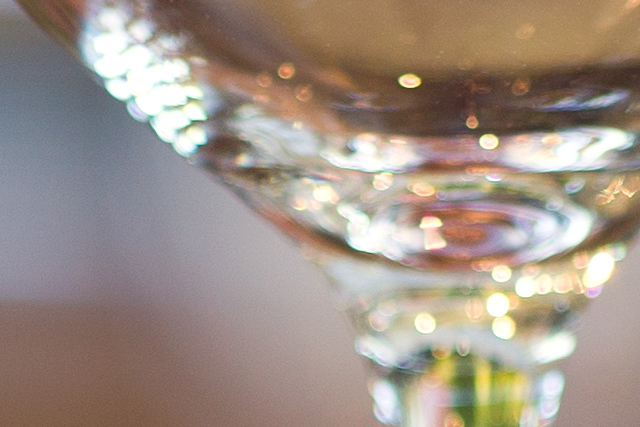
From these crops you can see that the AF-S Nikkor 1.8/85 G suffers from a strong "bokeh fringing" (the cyan and purple borders on contrast edges in slightly unsharp areas close to the focal plane - a certain kind of chromatic aberrations that is difficult to remove in post processing) whereas the crop of the Otus is almost free from bokeh fringing. The Batis (first crop) shows only a minor portion of this kind of CAs.
You can find the whole aperture series in full resolution when you click on the image below:
I had a good time when shooting with the Batis 1.8/85. It has a manageable size, provides fast and reliable autofocus and allows you to shoot also with longer exposure times on unstabilized cameras like the A7R due its built in optical image stabilization.
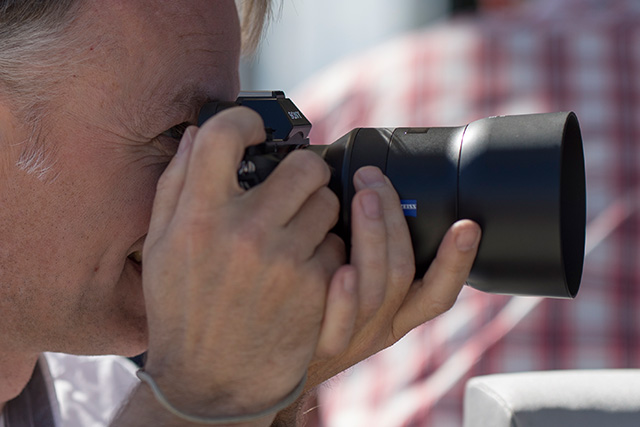
(picture taken by Dierk Topp)
Another shot from Dierk taken with with the Otus during that session:
ZEISS Batis 2/25
Second member of the new lens family is the Batis 2/25, based on a Distagon design with 10 elements in 8 groups with four two-sided aspherical lens elements. It has a field of view of 82 degree (diagonal) and a close focal distance of only 0.2m allowing to play with depth of field e.g. for food photography. It has a length of 78mm (without lens caps / sun hood), a M67 filter thread and weighs 335g. More detailed technical data including MTF charts can be found here.
During the little shootout session I compared it with the Sony/Zeiss FE 16-35mm f/4.0 OSS (see another comparison here) set to 25mm focal length.
Thank to its wide aperture, it gives you the option to play with depth of field. The following examples are provided without any lens correction profiles (the Sony A7R does not yet have a firmware supporting lens correction parameters for the Batis line and Adobe Lightroom / Camera Raw lens profiles are not available at the time of this writing).

(Batis 2/25 at f/2.0, click on the image to see further sizes)

(Batis 2/25 at f/2.0, click on the image to see further sizes)

(Batis 2/25 at f/2.0, click on the image to see further sizes)
If you take a closer look to the samples, you may recognize in high contrast situations a slight tendency to CAs at open aperture. These disappear when you stop down to f/2.8.
The main advantage of the Batis 2/25 is propably its extraordinary sharpness from corner to corner which makes it a good choice for landscape and architecture photographers as well. Already at f/2.0 the corners are sharper and have more contrast than the Sony FE 16-35/4 zoom (@25mm) stopped down to f/8.0! This is demonstrated with an aperture series shot with both lenses of this view:
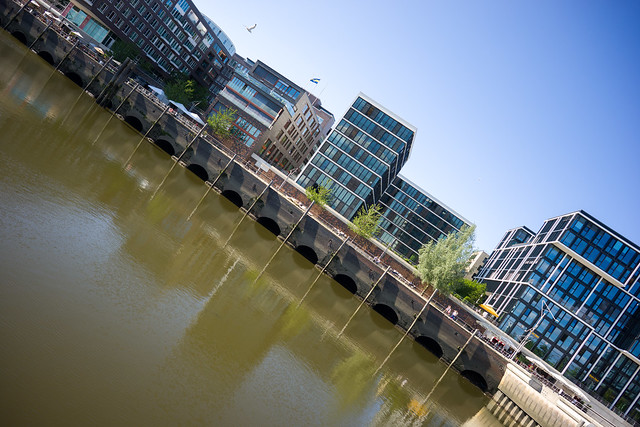
(Batis 2/25 @ f/4.0, click on the image for other sizes)
The following two crops are taken from the edges of comparable shots taken at f/5.6:
Top left edge crop from Batis 2/25 @ f/5.6 (no lens correction at all):
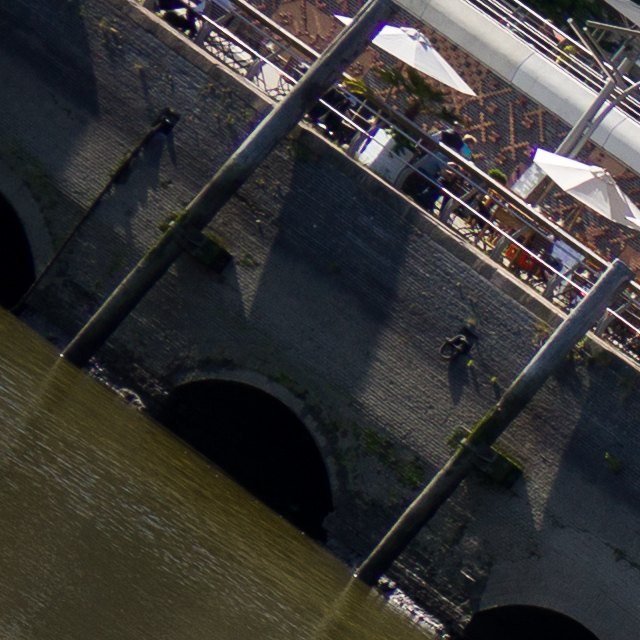
Top left edge crop of Zeiss FE 16-35 @ 25mm @ f/5.6 (in camera lens correction activated):
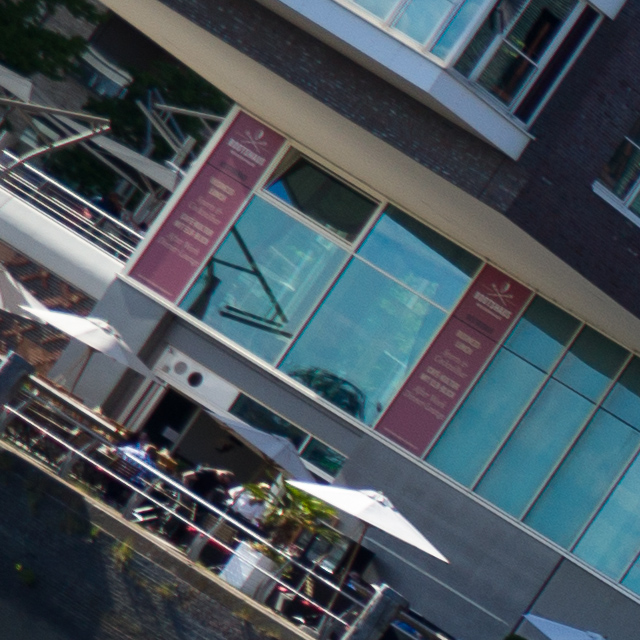
You can open the full resolution aperture series here, when you click on the image below:
Conclusion
Even though there was not much time for an in-depth look, I am sure, both members of the new Batis family will find friends easily and sell like hot cakes. The Batis 1.8/85 may not have the level of perfection like an Otus 1.4/85 and relies in some situations a bit more on lens correction profiles provided by camera firmware and/or raw processors but taking into account the enormous resolution and processing speed of today's cameras, this seems like a very well balanced compromise. This allows to provide a professional grade lens in a compact and lightweight form factor including autofocus and optical stabilization with a reasonable price tag.
The Batis 2/25 surprised me with extraordinary sharpness across the whole frame right from open aperture in a compact, lightweight housing. At f/2.0 you may have to correct some vignetting and some minor CAs but these almost disappear already when you stop down one step to f/2.8. Thanks to its wide aperture and short close focus, it provides additional options to play with depth of field and shows a pleasing bokeh not available when using wide angle zoom lenses.
There will be more stuff and comparisons in an enhanced review end June on this site, so stay tuned!
Credits
Some photos kindly provided by Dierk Topp (see his Flickr photo stream here).





